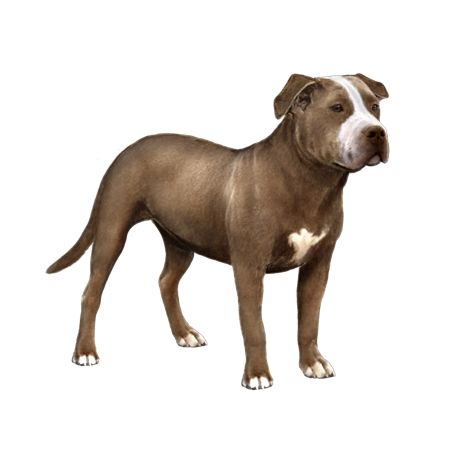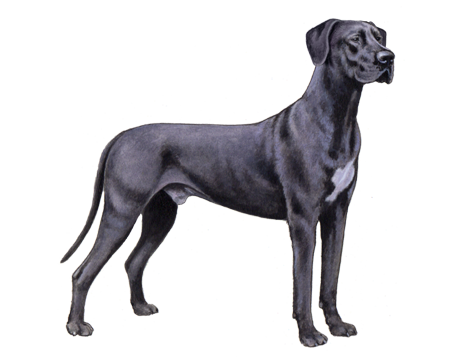
Perro de Presa Canario
The Perro de Presa Canarios is a confident, strong-willed, and intelligent breed. These composed and focused dogs were traditionally used for herding cattle and make good farm dogs. Loyal and calm with their family—but cautious of strangers—Perro de Presa Canarios are one tough breed.
Interested in discovering if your dog is a Perro de Presa Canario?
Check out Wisdom Panel's DNA tests.

Perro de Presa Canario Traits
General Appearance
A powerful and rare breed, the Perro de Presa Canario is a handsome, medium-sized dog with a dense, muscular body that exudes strength and power.
Coat and Colouring
The Perro de Presa Canario's short coat comes in brindle (generally brown and black stripes), as well as blue (gray) or blond, fawn, and sandy. White markings are possible on the chest and toes. According to the breed standard, if a mask is present, it should always be black.
Distinctive Physical Traits
Notable features of the Perro de Presa Canario include a solid, square head, and paws that are neat and round, with high-arched toes (also called a cat foot).
Perro de Presa Canario Temperament
Perro de Presa Canarios have steady dispositions. They are quiet, affectionate, and friendly dogs—but they're also protective of their territory and wary of strangers.
Presa Canarios don't always get along with other dogs. Early socialization is vital to help them be comfortable around dogs.
The calm personality of this breed makes it ideal for different types of living environments. They can be happy in a home with a yard or a large estate in the country.


Perro de Presa Canario History
Perro de Presa Canarios—also known as Dogo Canarios (Canary dog)—originated during the 19th century in the Canary Islands. Breeders developed these large dogs for dogfighting, guarding, and herding. Experts believe the Bardino Majero—a now extinct breed indigenous to the Canaries—and imported English Mastiffs contributed to the breed's development.
By the 1960s, Perro de Presa Canarios faced extinction. Dogfighting was outlawed, and popular foreign dogs such as the German Shepherd Dog, Doberman Pinscher, and Great Dane had arrived on the islands. As a result, the Perro de Presa Canario's numbers had dwindled. Fortunately, an American veterinarian named Dr. Carl Semenci revived the breed, giving these dogs a fighting chance.
The Perro de Presa Canario is a member of the American Kennel Club Foundation Stock Service.
Perro de Presa Canario Care
Nutrition
Presa Canarios require a high-quality dog food that is age-appropriate—whether it's commercially manufactured or homemade (with a veterinarian's supervision and approval).
As with any dog, it's important to monitor the amount of food you feed your Perro de Presa Canario and reduce the portions if your pup gains weight. Also, remember that too many treats on top of their regular meals can contribute to obesity.
Grooming
Weekly brushing and an occasional bath are all Perro de Presa Canarios need to keep them clean and looking their best. This breed has quick-growing nails that need regular trimming to prevent overgrowth, splitting, and cracking. And their ears should be checked consistently for wax buildup or debris.
Exercise
Perro de Presa Canarios are very energetic and athletic. They require daily physical exercise, such as long walks on a leash and training activities, including tracking and trailing.
They also need plenty of outdoor space (think large back yard) for roaming and playing. This is not a breed you're likely to find lying around and doing nothing.
Training
Perro de Presa Canarios require a strong, confident, dedicated, and experienced owner—someone to be the pack leader. Firm and structured trainin will help temper their instinct to guard and help them be safe household companions.
Perro de Presa Canarios learn quickly and are naturals when it comes to training. They're capable of learning many tasks, such as herding and obedience.

Perro de Presa Canario Genetic Health Conditions
-
Canine Multifocal Retinopathy 1
Canine Multifocal Retinopathy 1 (CMR1) is an eye disorder that can cause retinal decay which may impact vision, but very rarely results in blindness.
-
Chondrodystrophy (CDDY) and Intervertebral Disc Disease (IVDD) Risk
Chondrodystrophy (CDDY) is a skeletal disorder characterized by shortened limbs and abnormal early degeneration of the spinal discs, or intervertebral disc disease (IVDD), which predisposes to disc herniation.
Knowing if your Perro de Presa Canario is a carrier or at-risk for these conditions can help you and your veterinarian plan for your pup's lifelong care. With Wisdom Panel™ Premium, you can get results for over 200 genetic health tests.
Breed Group
Guard
Dogs of the Guard Group were bred to guard people and property. They are often quick to learn and these intelligent, capable animals make solid companions.
Resources
https://www.akc.org/dog-breeds/perro-de-presa-canario/
https://www.google.com/books/edition/Perro_De_Presa_Canario/mOwKBgAAQBA
Reviewed 26 July 2020 by Cindy Elston, DVM, MPH























